Technology Exchange
Diathermic forging
Application of induction heating in forging through heat
1 Introduction
The manufacturing industry is an extremely competitive industry, and all successful manufacturers are more focused on adopting more efficient and economical methods of production than ever before. Induction heating plays a very important role in the forging industry. Induction heating is not only much higher than traditional heating equipment in terms of heating cost and efficiency, but also has less pollution in both the production environment and the environment. Induction heating has a very wide application and development space in many processing and manufacturing industries.
2. Introduction to forging and induction heating
2.1 Introduction to forging
The forging concept referred to today includes free forging, die forging, extrusion, rolling, cold heading, cold punching and rolling and many other process methods. Except for cold heading and cold punching at room temperature, no matter what kind of forging is used The method requires preheating the metal blank to be forged so that the metal has good plasticity and low deformation resistance. The forged metal has a denser structure and higher mechanical properties.
Generally, the heating temperature of metal forging blanks depends on the recrystallization temperature of the metal. The forging temperature is closely related to the properties of the metal. The recrystallization temperature of steel is about 460°C. 300-800℃ is generally called warm forging; the hot forging of steel is generally between 800-1200℃ depending on the difference of alloy. For aluminum and aluminum alloys, the general forging temperature is around 400°C; the forging temperature of copper and copper alloys is 750-900°C; the forging temperature of titanium and titanium alloys is usually higher than 1000°C.
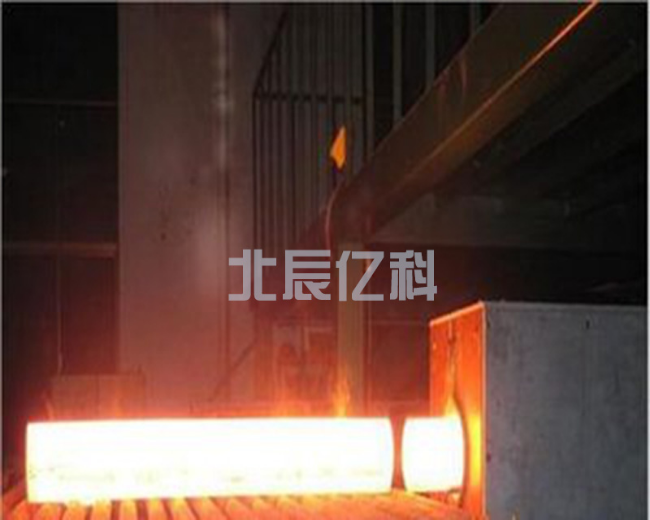
Figure 1 Billet heating
It goes without saying that the metal blank must be heated before forging. Any heat source that can raise the metal temperature to the requirements of the forging process can be used, but the choice of heating equipment still needs to consider the economics of energy, the investment cost of heating equipment construction, the possibility and stability of heating temperature control, to meet The requirements of environmental protection.
2.2 Introduction to induction heating
Induction heating is mostly used in many fields such as surface quenching of industrial metal parts, metal smelting, bar heat transfer, tool welding, etc. It is to generate a certain induction current inside the workpiece, form eddy currents, and quickly heat the surface of the part to achieve rapid surface heating, even The effect of melting through heat.
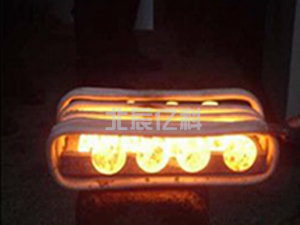 | 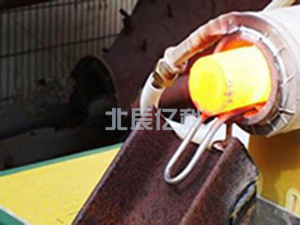 |
| Figure 2 Induction heating | |
1) Induction heating can instantly heat metal objects to the required temperature;
2) Induction heating does not need to generate high temperature before heating the metal object like other heating methods, it can directly generate high temperature in the metal object;
3) Induction heating can not only heat the metal object as a whole, but also selectively heat each part locally;
4) Induction heating is a revolution in heating methods. It is also electric heating, but it can save 40% of electricity compared to electric furnaces and electric ovens.
The basic principle of induction heating is to place the workpiece in an inductor made of copper pipes. A certain frequency of alternating current is passed into the inductor, and an alternating magnetic field with the same frequency will be generated around the inductor, so the workpiece will be Generate the same frequency induced current, this current forms a loop in the workpiece, called eddy current. This eddy current can turn electrical energy into heat to heat the workpiece. The distribution of eddy current in the workpiece is uneven, with high surface density and low core density. The higher the frequency of the current flowing into the inductor, the thinner the surface layer where the eddy current is concentrated. This phenomenon is called the skin effect. Due to the skin effect, the surface of the workpiece is quickly heated. When applied to forging through heat, the heating frequency needs to be determined according to the size of the blank, which is generally medium frequency, so that the temperature difference between the surface and the core is not too large.
3. The main components of forging and calculation of parameters
3.1 Main components of heating equipment
Most of the induction heating equipment in forging production consists of the following three parts:
(1) Power supply Most of the forging production is below 10KHZ and the power is 200-3000KW. Before the emergence of digital heating power supply, the main switching elements of the analog machine power supply were mostly thyristors, which were large in size and not convenient for automated production. The digital heating power supply is small in size and high in control accuracy, and can be connected with other control systems to realize automated production.
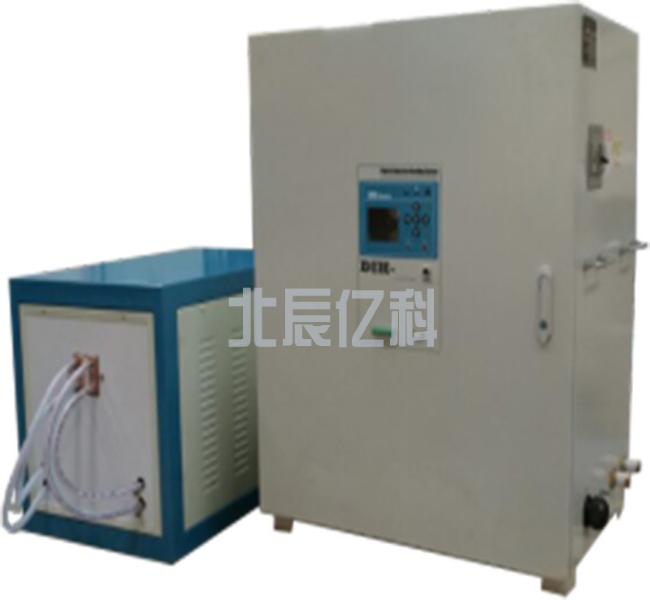
Figure 3 All-digital induction heating power supply
(2) Induction heating furnace The heating furnace is mainly composed of an induction coil wound by a copper tube and a sealed high temperature resistant structure. Its function is to convert electrical energy into heat energy to raise the temperature of the billet.
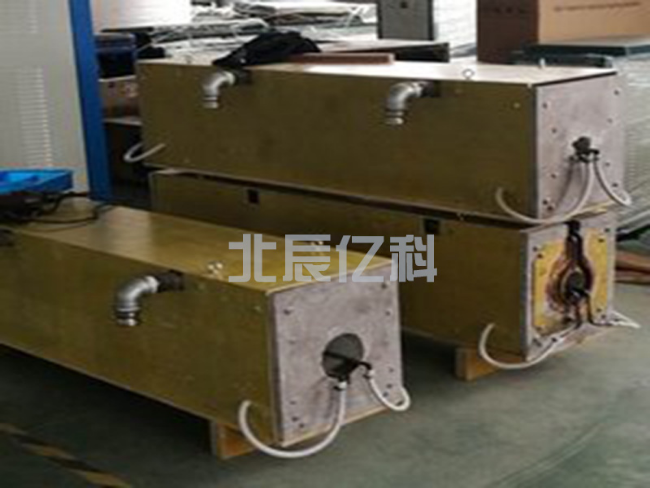
Figure 4 Heating furnace
(3) Control and operating system In forging production, the control and operating system mostly use PLC and operation panel to execute the production cycle. Intelligent and automatic control ensure high production accuracy and efficiency.
3.2 Parameter calculation
In forging production, the power and frequency of the heating power supply are mainly calculated.
(1) Power calculation
Diathermic power is a very important indicator. In diathermy, the energy density should be kept relatively low to allow heat conduction from the outer layer (which can be heated faster by higher current density) to the inner layer. After ignoring the effect of temperature gradient, the absorbed energy depends on the required temperature rise ΔT, the total weight m heated per unit time, and the specific heat Cm of the material.
P1=Cm*m*ΔT/s
Among them, P1 is the total power required for processing, the unit is kJ/s; Cm is the specific heat of the metal, the unit is
kJ/(kg*℃); m is the mass to be heated, the unit is kg; T is the temperature rise that needs to be heated, the unit is ℃.
Here P1 is the total processing power, and heat radiation P2 and coil loss P3 need to be considered. Of course, in the case of rapid heating, the heat radiation P2 can be ignored.
Thermal radiation P2=Aeσ(T14-T24), where A1 is the surface area of the workpiece, e is the surface emissivity of the workpiece, σ is the Spant-Boltzmann constant, T1 and T2 are the workpiece and the ambient temperature, respectively, in K Type temperature (K-type temperature is an absolute temperature of 273.15 degrees Celsius). In the range of 200 degrees Celsius to 595 degrees Celsius, the emissivity of steel is 0.8.
Coil loss P3 is the loss on the coil. This loss can be reduced by reducing the resistance of the induction coil. For example, using high-purity copper tubes or superconducting materials. This loss will cause the inductor to heat up and must be cooled.
Power P=(P1 P2 P3)*n, n is the heating efficiency, different materials have different heating efficiency. For example, the heating efficiency of steel is about 0.6.
(2) Frequency calculation
The selection of working frequency has very important significance for the uniformity of heat transmission and energy saving. When choosing a suitable operating frequency, you first need to understand the concept of penetration depth.
The penetration depth refers to the depth at which about 86% of the energy is concentrated.
d=50300
Among them, d is the penetration depth, the unit is c; P1 is the resistivity of the inductor at operating temperature, the unit is Ω·cm; f is the operating frequency, the unit is Hz; u1 is the relative permeability of the induction coil, without unit .
It should be noted that due to changes in resistivity and permeability, the penetration depth changes with changes in temperature. Generally, the resistivity is a positive temperature coefficient, that is, the resistivity increases as the temperature rises, so the penetration depth becomes deeper. For non-magnetic materials, the penetration depth is usually 2-3 times deeper. For magnetic permeability, magnetic loss may occur as the temperature rises. For example, when iron is around 770°C, the permeability will quickly drop to 1, and the penetration depth will increase by about 20 times.
The function of the ratio of the diameter a to the penetration depth d is called the resistivity of the workpiece. When a/d=4, the critical frequency at this time is the best heating frequency.
4. Conclusion
In this rapid industrialization process, high production efficiency and high-quality products are the common goals pursued by all production enterprises. Time means benefit, and quality determines how far it can go. Induction heating is widely used in the heat treatment processing industry by virtue of its unique advantages. With the development of more intelligent and miniaturized heating power sources, it is of great significance in various heat treatment industries, such as forging, welding, quenching, annealing, etc., with corresponding mechanical devices, fully automated production can be realized. With the emergence of new technologies, it is believed that induction heating will go further in the future.


 Scan and follow!
Scan and follow!